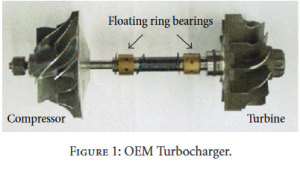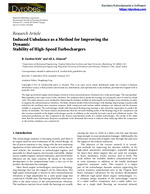Papers
“Induced Unbalance as a Method for Improving the Dynamic Stability of High-Speed Turbochargers,” |
Introduction
The turbocharger industry is booming recently, and there is an urgent need for new evaluations of the overall design.  As the oil prices continue to rise, along with the new emissions regulations strictly enforced for the in-road as well as the off-road vehicles, the transition to turbocharged engines, and especially for diesel engines, has become irresistible. Higher power, smaller engines, reduced emissions, and overall better efficiency are the main concerns. By means of the recent development in the computational tools, a new era of the product development has emerged. Most diesel engine turbochargers incorporate floating-ring bearings that use the engine’s oil for lubrication. The high-speed turbocharger is known to have subsynchronous vibrations at high amplitudes for a wide speed range that could reach 150,000 rpm. The bearing fluid-film whirl instability is the main source of the subsynchronous vibration. The nonlinear reaction forces inside the bearings are usually causing the rotor to whirl in a limit cycle but may become large enough to cause permanent damages. Additionally, the lubrication oil may leak at higher rates through the seals into the engine or the exhaust emissions. The objective of the current research is to investigate methods for improving the dynamic stability of the high-speed automotive turbochargers, especially designed for heavy-duty diesel engines that are used, for example, in heavy machinery, trucks, tractors, and so forth. The study utilizes the available modern computational tools in rotor dynamics in addition to the locally developed supportive computer codes. This research is a major part of the turbocharger dynamic analysis supporting the current extensive experimental tests in the Virginia Tech Rotor Dynamics Laboratory for the product development of different high-speed diesel engine turbochargers. A common design assembly of the turbocharger consists of a radial outflow compressor and a radial inflow turbine on a single shaft. Bearings are mounted inboard, with the compressor and turbine overhung, as shown in Figure 1.
As the oil prices continue to rise, along with the new emissions regulations strictly enforced for the in-road as well as the off-road vehicles, the transition to turbocharged engines, and especially for diesel engines, has become irresistible. Higher power, smaller engines, reduced emissions, and overall better efficiency are the main concerns. By means of the recent development in the computational tools, a new era of the product development has emerged. Most diesel engine turbochargers incorporate floating-ring bearings that use the engine’s oil for lubrication. The high-speed turbocharger is known to have subsynchronous vibrations at high amplitudes for a wide speed range that could reach 150,000 rpm. The bearing fluid-film whirl instability is the main source of the subsynchronous vibration. The nonlinear reaction forces inside the bearings are usually causing the rotor to whirl in a limit cycle but may become large enough to cause permanent damages. Additionally, the lubrication oil may leak at higher rates through the seals into the engine or the exhaust emissions. The objective of the current research is to investigate methods for improving the dynamic stability of the high-speed automotive turbochargers, especially designed for heavy-duty diesel engines that are used, for example, in heavy machinery, trucks, tractors, and so forth. The study utilizes the available modern computational tools in rotor dynamics in addition to the locally developed supportive computer codes. This research is a major part of the turbocharger dynamic analysis supporting the current extensive experimental tests in the Virginia Tech Rotor Dynamics Laboratory for the product development of different high-speed diesel engine turbochargers. A common design assembly of the turbocharger consists of a radial outflow compressor and a radial inflow turbine on a single shaft. Bearings are mounted inboard, with the compressor and turbine overhung, as shown in Figure 1.
This paper pioneers an alternative method in the suppression of high unstable vibrations of high-speed turbochargers. The new method is inducing the unbalance of the compressor and turbine wheels in order to suppress the instabilities. Several turbocharger finite-element models with various imbalance magnitudes on different locations are developed and numerically solved to obtain the nonlinear transient response in floating ring bearings. The dynamic coefficients of the floating ring bearings were also linearized and employed again in the turbocharger model to solve for eigenvalues and eigenvectors and hence the stability map of the rotor-bearing system. The numerical predictions are compared to the recent experimental results of a typical turbocharger with induced unbalance that was tested in the Virginia Tech Rotor Dynamics Laboratory…
Hindawi Publishing Corporation
International Journal of Rotating Machinery
Volume 2011, Article ID 952869, 9 pages
doi:10.1155/2011/952869
Copyright © 2011 R. Gordon Kirk and A. A. Alsaeed. This is an open access article distributed under the Creative Commons Attribution License, which permits unrestricted use, distribution, and reproduction in any medium, provided the original work is properly cited.

